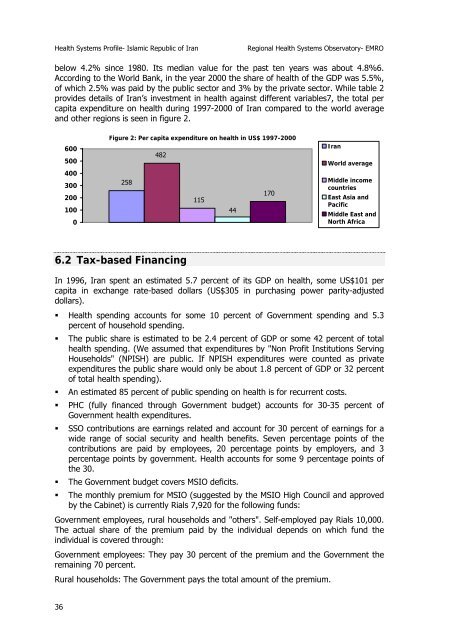Health system profile - Islamic Republic of Iran - What is GIS - World ...
Health system profile - Islamic Republic of Iran - What is GIS - World ...
Health system profile - Islamic Republic of Iran - What is GIS - World ...
You also want an ePaper? Increase the reach of your titles
YUMPU automatically turns print PDFs into web optimized ePapers that Google loves.
<strong>Health</strong> Systems Pr<strong>of</strong>ile- <strong>Islamic</strong> <strong>Republic</strong> <strong>of</strong> <strong>Iran</strong> Regional <strong>Health</strong> Systems Observatory- EMRO<br />
below 4.2% since 1980. Its median value for the past ten years was about 4.8%6.<br />
According to the <strong>World</strong> Bank, in the year 2000 the share <strong>of</strong> health <strong>of</strong> the GDP was 5.5%,<br />
<strong>of</strong> which 2.5% was paid by the public sector and 3% by the private sector. While table 2<br />
provides details <strong>of</strong> <strong>Iran</strong>’s investment in health against different variables7, the total per<br />
capita expenditure on health during 1997-2000 <strong>of</strong> <strong>Iran</strong> compared to the world average<br />
and other regions <strong>is</strong> seen in figure 2.<br />
600<br />
500<br />
400<br />
300<br />
200<br />
100<br />
0<br />
Figure 2: Per capita expenditure on health in US$ 1997-2000<br />
258<br />
482<br />
6.2 Tax-based Financing<br />
115<br />
44<br />
170<br />
<strong>Iran</strong><br />
<strong>World</strong> average<br />
Middle income<br />
countries<br />
East Asia and<br />
Pacific<br />
Middle East and<br />
North Africa<br />
In 1996, <strong>Iran</strong> spent an estimated 5.7 percent <strong>of</strong> its GDP on health, some US$101 per<br />
capita in exchange rate-based dollars (US$305 in purchasing power parity-adjusted<br />
dollars).<br />
<strong>Health</strong> spending accounts for some 10 percent <strong>of</strong> Government spending and 5.3<br />
percent <strong>of</strong> household spending.<br />
The public share <strong>is</strong> estimated to be 2.4 percent <strong>of</strong> GDP or some 42 percent <strong>of</strong> total<br />
health spending. (We assumed that expenditures by "Non Pr<strong>of</strong>it Institutions Serving<br />
Households" (NPISH) are public. If NPISH expenditures were counted as private<br />
expenditures the public share would only be about 1.8 percent <strong>of</strong> GDP or 32 percent<br />
<strong>of</strong> total health spending).<br />
An estimated 85 percent <strong>of</strong> public spending on health <strong>is</strong> for recurrent costs.<br />
PHC (fully financed through Government budget) accounts for 30-35 percent <strong>of</strong><br />
Government health expenditures.<br />
SSO contributions are earnings related and account for 30 percent <strong>of</strong> earnings for a<br />
wide range <strong>of</strong> social security and health benefits. Seven percentage points <strong>of</strong> the<br />
contributions are paid by employees, 20 percentage points by employers, and 3<br />
percentage points by government. <strong>Health</strong> accounts for some 9 percentage points <strong>of</strong><br />
the 30.<br />
The Government budget covers MSIO deficits.<br />
The monthly premium for MSIO (suggested by the MSIO High Council and approved<br />
by the Cabinet) <strong>is</strong> currently Rials 7,920 for the following funds:<br />
Government employees, rural households and "others". Self-employed pay Rials 10,000.<br />
The actual share <strong>of</strong> the premium paid by the individual depends on which fund the<br />
individual <strong>is</strong> covered through:<br />
Government employees: They pay 30 percent <strong>of</strong> the premium and the Government the<br />
remaining 70 percent.<br />
Rural households: The Government pays the total amount <strong>of</strong> the premium.<br />
36

















